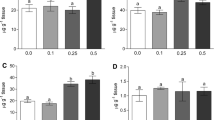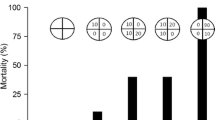Abstract
Nitric oxide (NO) is a mediator and biomarker of pro- and anti-inflammatory processes. Excessive levels of NO for long periods have been associated with inflammation and tissue damage. The metabolism and synthesis of NO is usually measured indirectly, as metabolites and enzymes involved in reactions, often as the nitrite/nitrate (NOx) level. The aim of the present study was to measure the NOx levels in vital organs of juvenile silver catfish (Rhamdia quelen) exposed to various levels of eprinomectin in the water. The fish were exposed for 24 and 48 h to start concentration (0 h) of eprinomectin in water (0.0, 1.12, 1.80, and 3.97 μg/L). The eprinomectin concentrations in water were lower at 24 h (0.0, 0.85, 1.14, and 1.15 μg/L) and 48 h (0.0, 0.39, 0.69, and 1.28 μg/L), due to the process of eprinomectin metabolization. Subsequently, the fish were left for 48 h of recovery in eprinomectin-free water. NO levels were measured indirectly, as NOx levels in brain, liver, and gill tissue. Within 24 h of exposure, there was no significant increase in NOx levels in the organs evaluated at any of the concentrations tested. However, increases in NOx levels did occur at 48 h of exposure in all organs, particularly at the two highest concentrations of eprinomectin (1.80 and 3.97 μg/L). The transfer of fish to eprinomectin-free water did not result in reversal of NOx levels after 48 h of recovery, especially in fish that had been exposed to the two highest concentrations in the brain and liver tissues, and for the highest concentration in the gills. We conclude that silver catfish exposed to eprinomectin for up to 48 h present possible cerebral, hepatic, and branchial inflammatory process associated with increased tissue NOx levels, and that recovery for 48 h in water without antiparasitic is insufficient for the fish to recover from the poisoning.



Similar content being viewed by others
References
Alak G, Yeltekin AÇ, Tas IH, Ucar A, Parlak V, Topal A, Kocaman EM, Atamanalp M (2017) Investigation of 8-OHdG, CYP1A, HSP70 and transcriptional analyses of antioxidant defense system in liver tissues of rainbow trout exposed to eprinomectin. Fish Shellfish Immunol 65:136–144. https://doi.org/10.1016/j.fsi.2017.04.004
Bahadoran Z, Carlstrom M, Mirmiran P, Ghasemi A (2020) Nitric oxide: to be or not to be an endocrine hormone? Acta Physiol 229:e13443. https://doi.org/10.1111/apha.13443
Baldissera MD, Souza CF, Doleski PH, Moreira KLS, Da Rocha MIUM, Da Veiga ML, Santos RCV, Baldisserotto B (2017) Xanthine oxidase activity exerts a pro-oxidant and pro-inflammatory profile in gills of experimentally infected silver catfish with Streptococcus agalactiae. Aquaculture 477:71–75. https://doi.org/10.1016/j.aquaculture.2017.04.025
Baldissera MD, Souza CF, Descovi SN, Zanella R, Stefani LM, Da Silva AS, Baldisserotto B (2018a) Purinergic signalling as a potential pathway for trichlorfon induced-inflammation and impairment of the immune response using freshwater silver catfish. Aquaculture 497:91–96. https://doi.org/10.1016/j.aquaculture.2018.07.037
Baldissera MD, Souza CF, Santos RCV, Baldisserotto B (2018b) Purinergic system displays an anti-inflammatory profile in serum of silver catfish experimentally infected with Streptococcus agalactiae: an attempt to ameliorate the inflammatory response. Microb Pathog 114:193–196. https://doi.org/10.1016/j.micpath.2017.11.060
Da Cunha MA, Zeppenfeld CC, Garcia LO, Loro VL, Da Fonseca MB, Emanuelli T, Veeck APL, Copatti CE, Baldisserotto B (2010) Anesthesia of silver catfish with eugenol: time of induction, cortisol response and sensory analysis of fillet. Ciência Rural 40:2107–2114. https://doi.org/10.1590/S0103-84782010005000154
Flora Filho R, Zilberstein B (2000) Óxido nítrico: o simples mensageiro percorrendo a complexidade. Metabolismo, síntese e funções. Rev Assoc Méd Bras 46:265–271. https://doi.org/10.1590/S0104-42302000000300012
Kozan E, Sevimli FK, Birdane FM, Adanir R (2008) Efficacy of eprinomectin against Toxocara canis in dogs. Parasitol Res 102(397–400):2008–2400. https://doi.org/10.1007/s00436-007-0776-4
Kvaternick V, Kellermann M, Knaus M, Rehbein S, Rosentel J (2014) Pharmacokinets and metabolism of eprinomectin in cats when administered in a novel topical combination of fipronil, (S)-methoprene, eprinomection and praziquantel. Vet Parasitol 202:2–9. https://doi.org/10.1016/j.vetpar.2014.02.031
Maharajan K, Muthulakshmi S, Nataraj B, Ramesh M, Kadirvelu K (2018) Toxicity assessment of pyriproxyfen in vertebrate model zebrafish embryos (Danio rerio): a multi biomarker study. Aquat Toxicol 196:132–145. https://doi.org/10.1016/j.aquatox.2018.01.010
Merck (1996) Ivomec Eprinex (eprinomectin) pour-on for beef and dairy cattle: environmental assessment. Report NADA 141-079EA. Merck and Company, Rahway
Ozdemir S, Altun S, Arslan H (2018) Imidacloprid exposure cause the histopathological changes, activation of TNF-α, iNOS, 8-OHdG biomarkers, and alteration of caspase 3, iNOS, CYP1A, MT1 gene expression levels in common carp (Cyprinus carpio L.). Toxicol Rep 5:125–138. https://doi.org/10.1016/j.toxrep.2017.12.019
Rao MR, Kanji VK, Sekhar V (1999) Pesticide induced changes of nitric oxide synthase in rat brain in vitro. Drug Chem Toxicol 22:411–420. https://doi.org/10.3109/01480549909017844
Serafini S, Soares JG, Perosa CF, Picoli F, Segat JC, Da Silva AS, Baretta D (2019a) Eprinomectin antiparasitic affects survival, reproduction and behavior of Folsomia candida biomarker, and its toxicity depends on the type of soil. Environ Toxicol Pharmacol 72:103262. https://doi.org/10.1016/j.etap.2019.103262
Serafini S, Souza CF, Baldissera MD, Baldisserotto B, Picoli F, Segat JC, Baretta D, Da Silva AS (2019b) Fish exposed to eprinomectin show hepatic oxidative stress and impairment in enzymes of the phosphotransfer network. Aquaculture 508:199–205. https://doi.org/10.1016/j.aquaculture.2019.04.081
Serafini S, Souza CF, Baldissera MD, Baldisserotto B, Segat JC, Baretta D, Zanella R, Da Silva AS (2019c) Fish exposed to water contaminated with eprinomectin show inhibition of the activities of AChE and Na+/K+-ATPase in the brain, and changes in natural behavior. Chemosphere 223:124–130. https://doi.org/10.1016/j.chemosphere.2019.02.026
Souza CF, Baldissera MD, Moreira KLS, Da Rocha MIUM, Da Veiga ML, Santos RCV, Baldisserotto B (2017) Involvement of xanthine oxidase activity with oxidative and inflammatory renal damage in silver catfish experimentally infected with Streptococcus agalactiae: interplay with reactive oxygen species and nitric oxide. Microb Pathog 111:1–5. https://doi.org/10.1016/j.micpath.2017.08.010
Tatsch E, Bochi GV, Pereira RS, Kober H, Agertt VA, De Campos MMA, Gomes P, Duarte MMMF, Moresco RN (2011) A simple and inexpensive automated technique for measurement of serum nitrite/nitrate. Clin Biochem 44:348–350. https://doi.org/10.1016/j.clinbiochem.2010.12.011
Thomas DD, Ridnour LA, Isenberg JS, Flores-Santana W, Switzer CH, Donzellie S, Hussain P, Vecoli C, Paolocci N, Ambs S, Colton C, Harris C, Roberts DD, Wink DA (2008) The chemical biology of nitric oxide. Implications in cellular signaling. Free Radic Biol Med 45:18–31. https://doi.org/10.1016/j.freeradbiomed.2008.03.020
Acknowledgments
The authors would like to thank the CAPES (Brazil) and CNPq (Brazil) for their technical and financial support.
Author information
Authors and Affiliations
Corresponding author
Ethics declarations
Ethics committee
This study was approved by the Ethical and Animal Welfare Committee of the Universidade do Estado de Santa Catarina (protocol number 4679260518).
Conflict of interest
The authors declare that they have no conflicts of interest.
Additional information
Publisher’s note
Springer Nature remains neutral with regard to jurisdictional claims in published maps and institutional affiliations.
Rights and permissions
About this article
Cite this article
Serafini, S., de Freitas Souza, C., Baldissera, M.D. et al. Nitric oxide levels in brain, liver, and gills of silver catfish (Rhamdia quelen) exposed to the antiparasitic eprinomectin. Fish Physiol Biochem 46, 1867–1872 (2020). https://doi.org/10.1007/s10695-020-00836-2
Received:
Accepted:
Published:
Issue Date:
DOI: https://doi.org/10.1007/s10695-020-00836-2




